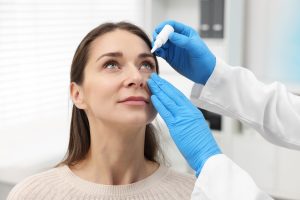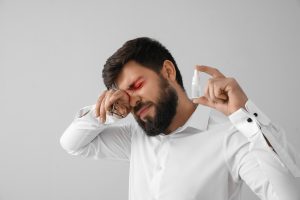Dry Eye Therapy in Toronto
What Is Dry Eye Syndrome?
 Dry eye syndrome is a chronic eye disease characterized by the eye’s inability to produce quality tears to lubricate the eye or the tears are not properly absorbed. Dry eye syndrome has many symptoms, one of which is tearing. This symptom may be confusing to patients as a symptom of dry eye because one may excessive tearing is contradictory to dryness. However, when the eye is dry, it begins to generate an excessive amount of tears to help restore moisture; unfortunately, the tears are not of an adequate pH quality.
Dry eye syndrome is a chronic eye disease characterized by the eye’s inability to produce quality tears to lubricate the eye or the tears are not properly absorbed. Dry eye syndrome has many symptoms, one of which is tearing. This symptom may be confusing to patients as a symptom of dry eye because one may excessive tearing is contradictory to dryness. However, when the eye is dry, it begins to generate an excessive amount of tears to help restore moisture; unfortunately, the tears are not of an adequate pH quality.
Dry eye syndrome is the most common eye disease, affecting 5-6% of the population and up to 6-10% of post-menopausal women. That number increases to 36% in elderly individuals.
Dry eyes, also known as dry eye syndrome or keratoconjunctivitis sicca, is a condition where the eyes do not produce enough tears or the tears evaporate too quickly. This leads to discomfort, irritation, and, in some cases, inflammation of the eyes. Common symptoms of dry eyes include:
- Stinging or burning sensation: The eyes may feel like they are burning or stinging.
- Grittiness or feeling of a foreign body: It can feel like there is something gritty or a foreign object in the eye.
- Redness: The eyes may appear red or bloodshot.
- Blurry vision: Vision may become temporarily blurry, especially during activities that require prolonged visual concentration, such as reading or using a computer.
- Sensitivity to light: Also known as photophobia, sensitivity to light may increase.
- Watery eyes: Paradoxically, dry eyes can sometimes cause an overproduction of tears in response to the irritation.
Causes of dry eyes include aging, hormonal changes, environmental factors (like dry climates or air conditioning), certain medications, and underlying health conditions such as autoimmune diseases. Management typically involves using artificial tears, addressing underlying causes, and, in some cases, using prescription medications or procedures to help improve tear production and reduce symptoms.
Dry Eye Inflammation Causes & Treatments
Inflammation plays a key role in dry eye disease by disrupting the normal function of the tear glands and tear film. When the ocular surface or tear-producing glands (like the lacrimal and meibomian glands) become inflamed, they produce fewer and poorer-quality tears. This leads to a breakdown of the tear film, causing dryness, irritation, and a self-perpetuating cycle of inflammation.
How Inflammation Causes Dry Eyes:
- Inflammation can damage the cells that produce the watery, oily, and mucous layers of the tear film.
- It can cause swelling and blockage in the tear ducts and Meibomian glands, reducing tear secretion and quality.
- Inflammatory cells release cytokines and other mediators that disrupt the balance of the tear film, further aggravating dryness.
How Drugs Like Cyclosporine Help:
- Cyclosporine (commonly sold as Restasis) is an immunomodulatory drug that suppresses the immune response, specifically targeting inflammation in the eyes.
- It reduces the activity of T-cells, which are key drivers of the inflammatory process.
- By lowering inflammation, cyclosporine helps restore normal tear production, improve tear quality, and prevent further damage to the tear-producing glands.
- Over time, this helps stabilize the tear film and relieve dry eye symptoms.
Other drugs like lifitegrast (Xiidra) also target inflammation by blocking a specific protein (LFA-1) that contributes to the inflammatory response in dry eye disease.
How is Dry Eye Diagnosed?
Determining whether you suffer from dry eye syndrome and determining the severity of the condition can be measured in a number of ways. A comprehensive examination of your overall health and examination of the cornea is generally the first step to determining if a patient suffers from dry eye syndrome. Once diagnosed, there are several treatment options considered depending on the severity of the condition.
Schirmer’s Test
Additionally, Schirmer’s test measures basic tear function. This test involves inserting paper test strips under the lower eyelids for a short duration of time. Once the paper is removed, the tear secretion on the paper is measured and can provide information on the severity of dry eye.
TearLab Dry Eye Diagnostics
Our clinic is an accredited dry eye centre providing the latest and most accurate diagnostics in dry eye management. Dr. Skouras is one of the few eye doctors offering the TearLab Osmolarity System in Toronto.
What is Tear Lab?
The TearLab Osmolarity System is the first objective and quantitative test for diagnosing and treating patients with dry eye syndrome. This system provides fast and accurate results that only require a small amount of tear film to diagnose dry eyes.
How is Tear Osmolarity Measured with TearLab?
TearLab is a faster, more comfortable, non invasive tear film diagnostic than traditional testing. It requires no anesthetics and uses even less tear film than the size of the period at the end of this sentence. A technician will direct you to tilt your head to the side, allowing your tears to collect in the outer corners of the eye. She then uses a small handheld device that absorbs only 50 nanoliters of tears to provide accurate results of the content of your tears. You can watch the TearLab test here
TearLab then generates an osmolarity number using a scale from normal, mild, moderate, to severe that gives an accurate interpretation to the level of severity of your dry eye condition.
The osmolarity number provides Dr. Skouras with the best options for treatment, often eliminating the redundant preliminary diagnostic therapy associated with dry eye treatment in patients with severe dry eyes and allowing treatment with more aggressive treatment options sooner. This allows Dr. Skouras to intervene early in the disease process and provide customized treatment options for individual care.
Once Dr. Skouras has evaluated your osmolarity number and provided you with treatment options, a follow-up visit will be provided. Upon this visit, your tear osmolarity will be measured again providing Dr. Skouras with accurate results on your response to that treatment.
Radio Frequency Dry Eye Treatment
Radio frequency dry eye treatment, also known as radio frequency thermotherapy or RF heating, is a non-invasive procedure that can offer several benefits for individuals suffering from dry eye syndrome:
- Improved Tear Production: RF treatment can stimulate the meibomian glands, which are responsible for producing the oily layer of tears that prevent evaporation. By enhancing gland function, it can improve tear quality and quantity.
- Reduced Inflammation: RF therapy can help reduce inflammation in the eyelids and around the eyes, which is often a contributing factor to dry eye syndrome.
- Enhanced Comfort: Many patients report experiencing relief from symptoms such as eye irritation, burning, and discomfort following RF treatment.
- Long-lasting Results: While multiple sessions may be needed initially, RF treatment can provide long-lasting relief from dry eye symptoms for many patients, reducing the need for ongoing medication or eye drops.
- Non-surgical: RF therapy is a non-surgical procedure that is typically performed in-office. It does not require incisions or anesthesia, making it a convenient and relatively low-risk option for managing dry eye.
- Minimal Downtime: Patients can typically resume their normal activities immediately after treatment, as there is usually little to no downtime associated with RF dry eye therapy.
It’s important to note that the effectiveness of RF treatment may vary depending on the individual’s specific condition and other factors. Consulting with an eye care professional is essential to determine if RF therapy is a suitable option and to discuss potential risks and benefits.
